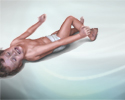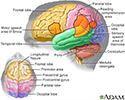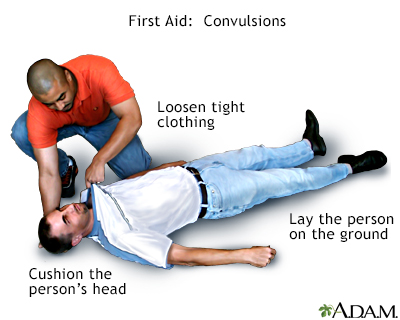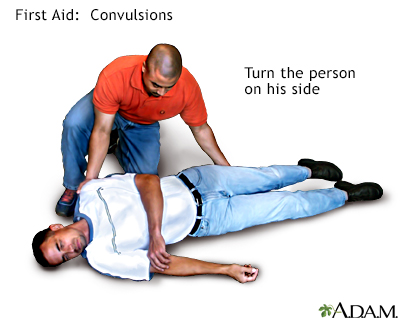Bilateral tonic-clonic seizure
Seizure - tonic-clonic; Seizure - grand mal; Grand mal seizure; Seizure - generalized; Epilepsy - generalized seizureBilateral tonic-clonic seizure is a type of seizure that involves the entire body. It is also called grand mal seizure. The terms generalized seizure, convulsion, or epilepsy are most often associated with bilateral tonic-clonic seizures.
Convulsion
A seizure is the physical changes in behavior that occurs during an episode of specific types of abnormal electrical activity in the brain. The term ...

Epilepsy
Epilepsy is a brain disorder in which a person has repeated seizures over time. Seizures are episodes of uncontrolled and abnormal electrical activi...

Causes
Seizures result from electrical overactivity in the brain. Bilateral tonic-clonic seizures may occur in people of any age. They can occur once (single episode). Or, they can occur as part of a repeated, chronic illness (epilepsy). Some seizures are due to psychological problems (psychogenic or non-epileptic).
Symptoms
Many people with generalized bilateral tonic-clonic seizures have an aura with one or more symptoms before the seizure such as:
- Vision, taste, smell, or sensory changes.
- Seeing, smelling, or sometimes hearing things that are not there (hallucinations).
Hallucinations
Hallucinations involve sensing things such as visions, sounds, or smells that seem real but are not. These things are created by the mind.
 ImageRead Article Now Book Mark Article
ImageRead Article Now Book Mark Article - Dizziness or other symptoms.
Dizziness
Dizziness is a term that is often used to describe 2 different symptoms: lightheadedness and vertigo. Lightheadedness is a feeling that you might fai...
 ImageRead Article Now Book Mark Article
ImageRead Article Now Book Mark Article
Some people have a focal onset seizure (only affecting one part of the body) that becomes a bilateral tonic-clonic seizure.
The seizures often result in rigid muscles (tonic phase). This is followed by violent muscle contractions (clonic phase). Other symptoms that occur during the seizure may include:
Muscle contractions
Muscle cramps are when a muscle gets tight (contracts) without you trying to tighten it, and it does not relax. Cramps may involve all or part of on...

- Biting the cheek or tongue
- Clenched teeth or jaw
- Loss of urine or stool control (incontinence)
-
Stopped breathing or difficulty breathing
Difficulty breathing
Breathing difficulty may involve:Difficult breathing Uncomfortable breathingFeeling like you are not getting enough air
 ImageRead Article Now Book Mark Article
ImageRead Article Now Book Mark Article - Blue skin color (cyanosis)
Blue skin color
A bluish color to the skin or mucous membrane is usually due to a lack of oxygen in the blood. The medical term is cyanosis.
 ImageRead Article Now Book Mark Article
ImageRead Article Now Book Mark Article
After the seizure, the person may have:
- Confusion
Confusion
Confusion is the inability to think as clearly or quickly as you normally do. You may feel disoriented and have difficulty paying attention, remembe...
 ImageRead Article Now Book Mark Article
ImageRead Article Now Book Mark Article - Drowsiness or sleepiness that lasts for 1 hour or longer (called the post-ictal state)
Drowsiness
Drowsiness refers to feeling more sleepy than normal during the day. People who are drowsy may fall asleep when they do not want to or at times whic...
 ImageRead Article Now Book Mark Article
ImageRead Article Now Book Mark Article - Loss of memory (amnesia) about the seizure episode
- Headache
Headache
A headache is pain or discomfort in the head, scalp, or neck. Serious causes of headaches are rare. Most people with headaches can feel much better...
 ImageRead Article Now Book Mark Article
ImageRead Article Now Book Mark Article - Weakness of one side of the body for a few minutes to a few hours following seizure (called Todd paralysis)
Exams and Tests
Your health care provider will perform a physical exam. This will include a detailed check of the brain and nervous system.
An electroencephalogram (EEG) will be done to check the electrical activity in the brain. People with seizures often have abnormal electrical activity seen on this test. In some cases, the test shows the area in the brain where the seizures start. The brain may appear normal after a seizure or between seizures.
Electroencephalogram
An electroencephalogram (EEG) is a test to measure the electrical activity of the brain.

Blood and urine tests may also be ordered to check for other health problems that may be causing the seizures.
Head CT or MRI scan may be done to find the cause and location of the problem in the brain.
Head CT
A head computed tomography (CT) scan uses many x-rays to create pictures of the head, including the skull, brain, eye sockets, and sinuses.

MRI
A head MRI (magnetic resonance imaging) is an imaging test that uses powerful magnets and radio waves to create pictures of the brain and surrounding...

Treatment
Treatment for tonic-clonic seizures includes medicines, changes in lifestyle for adults and children, such as activity and diet, and sometimes surgery. Your provider can tell you more about these options.
Treatment
Epilepsy is a brain disorder in which a person has repeated seizures over time. Seizures are episodes of uncontrolled and abnormal electrical activi...

Adults
You have epilepsy. People with epilepsy have seizures. A seizure is a sudden brief change in the electrical and chemical activity in the brain. Aft...
Read Article Now Book Mark ArticleChildren
Your child has epilepsy. People with epilepsy have seizures. A seizure is a sudden brief change in the electrical and chemical activity in the brai...
Read Article Now Book Mark ArticleReferences
Abou-Khalil BW, Gallagher MJ, Macdonald RL. Epilepsies. In: Jankovic J, Mazziotta JC, Pomeroy SL, Newman NJ, eds. Bradley and Daroff's Neurology in Clinical Practice. 8th ed. Philadelphia, PA: Elsevier; 2022:chap 100.
Kanner AM, Ashman E, Gloss D, et al. Practice guideline update summary: Efficacy and tolerability of the new antiepileptic drugs I: Treatment of new-onset epilepsy: Report of the Guideline Development, Dissemination, and Implementation Subcommittee of the American Academy of Neurology and the American Epilepsy Society. Neurology. 2018;91(2):74-81. PMID: 29898971 pubmed.ncbi.nlm.nih.gov/29898971/.
Mikati MA, Tchapyjnikov D, Rathke KM. Seizures in childhood. In: Kliegman RM, St. Geme JW, Blum NJ, et al, eds. Nelson Textbook of Pediatrics. 22nd ed. Philadelphia, PA: Elsevier; 2025:chap 633.
Wiebe S. The epilepsies. In: Goldman L, Cooney KA, eds. Goldman-Cecil Medicine. 27th ed. Philadelphia, PA: Elsevier; 2024:chap 372.
Review Date: 3/31/2024
Reviewed By: Joseph V. Campellone, MD, Department of Neurology, Cooper Medical School at Rowan University, Camden, NJ. Review provided by VeriMed Healthcare Network. Also reviewed by David C. Dugdale, MD, Medical Director, Brenda Conaway, Editorial Director, and the A.D.A.M. Editorial team.





